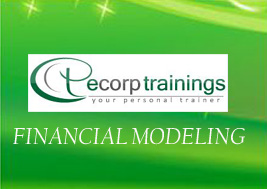FINANCIAL MODELING TRAINING COURSE
What is Financial Modelling?
Financial Modeling is one of the most fundamental and widely sought after skills in the finance industry. It is the art of building a model to depict financial statements and investment analysis using MS Excel. This helps arrive at optimal business solutions by analyzing various parameters. At the end of the course,You will be able to do the task of building a model depicting financial statements/business model, which helps in decision making. The EduPristine Financial Modeling course will teach you the basic of MS Excel all the way to creating successful Financial Models. By the end of the course, you will be able to independently build models that are robust and provide dynamic projections that can be used to thoroughly analyze a company from multiple standpoints: operations, investment, financing and valuation.


What are the Pre-requisites to Learn Financial Modelling?
- Students should have hands-on experience with Excel and a brief idea about Finance, Balance Sheets and Cash Flow Models.
Financial Modeling Course Syllabus:
Excel Tips
Case Study FMCG
Project Finance
M&A I & II
Accenture Case Study
Macros I
Macros II
Charting
Advance Function
- Understanding And Creating A Financial Model Template
- Learning referencing (usage of $)Frame work in Excel
- Learning Custom formatting in Excel
- Excel Skills - Shortcuts, Formulas, Array Function and Pivot Tables
- Implementing simple business modeling case in Excel
- Simple exercise/models in excel
Case Study FMCG
- Data Collection and Data Structuring
- Preliminary Scrutiny of the Data and Information
- Understand the Business Model and Operating Model
- Modeling the Historical Statement
- Business Drivers Identification and Modeling
- Modeling Assumptions for Future Action
- Modeling Revenue Build-up - projecting the future revenues
- Modeling Cost Build-up - projecting the future cost
- Modeling the Asset Schedule
- Modeling the Depreciation Schedule - Book and Income Tax Depreciation
- Working Capital & Term Loan Modeling - Debt Infusion
- Tax Modeling
- Modeling MAT and MAT credit
- Modeling Impact of Accumulated Losses, Current Tax and Deferred Tax on Tax Payble
- Equity Modeling - Equity Infusion
- Modeling Paid Up Capital and Share Premium Account
- Modeling Retained Earning Schedule
- Modeling the projected P/L and BS
- Modeling the projected Cash Flow Statement
- Conducting Covenant Testing
- Performing Ratio Analysis
- WACC and Cost of Equity Analysis
- Performing Valuation using DCF (FCFF & Enterprise Value) and Comparable analysis (Relative Valuation)
- Performing sensitivity/scenario analysis
Project Finance
- Understanding the Project Finance Model
- Characteristics of Project Finance
- Risk and contractual arrangement to Mitigate Risk
- Understanding the Escrow Arrangement
- Incorporating Date, logical functions and flags to make the Model Flexible
- Incorporating Delays in the Model
- Cash Flow Waterfall model - Modeling Payoffs to Investors using Goal Seek
- Implementing Interest During Construction and Breaking Circular Loops
M&A I & II
- Meaning and categories of M&A
- Merger motivations
- Forms of payment in a Merger Deal
- Hostile Vs Friendly offer
- Evaluating a Merger Bid
- Merger Analysis - Key Drivers and Inputs
- Accretion/Dilution Analysis
- Merger Plan - Ownership Vs Deal Price
- Modeling a financing plan
- Performing sensitivity analysis on Acquirer's EPS
- Performing Contribution Analysis
- Estimating value of a Merger Transaction
- Discounted Cashflow Analysis
- Comparable Company Analysis
- Comparable Transaction Analysis
Accenture Case Study
- Data Collection from Public Sources
- Understanding the Business Profile of the Company
- Modeling Revenue & Expenses Drivers
- Modeling Income Statement
- Modeling Implied EBITDA
- Balance Sheet Projections
- Cash Flow Statement Projection
- Performing Valuation And Sensitivity Analysis
- Calculating Enterprise value and Implied Market capitalization
Macros I
- Introduction to Macros & Advanced Application Building in Excel
- Key Concepts in Macros
- Macros as recorded Robots!
- Form Controls and Active X controls
- Implementing user forms in Excel Macros
- Linking forms to excel cells
- Building flexible Charts in Excel
Macros II
- Understanding VBA - Sub & Functions
- Understanding the Relevant Language Constructs
- IDC Implementation using Macros
- Breaking Circular Loops using Macro
- Monte Carlo Simulation
- Basics of Debugging VBA Code
Charting
- Building Primary & Secondary Axis in a Chart
- Radar Charts - Showing the progress of Commercial Property Development
- Waterfall Charts - Showing Funding Breakup for Renewable Energy project
- Football Field - Showing Valuation Summary using Different Parameters
- Gantt Chart - Tracking the status of an Ongoing Project
Advance Function
- Named Ranges
- Index Match
- Array Functions
- Building Scenarios using Offset Functions
- Creating growing models & Index functions
- Usage of Indirect Functions
- Usage of Goal Seek and Solver Functions
